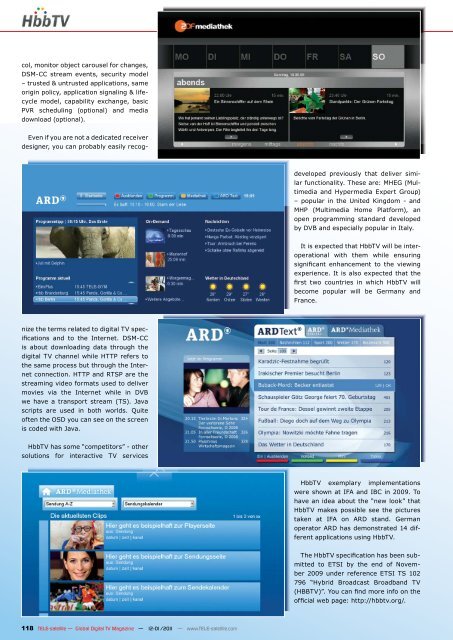TELEsatelit - TELE-satellite International Magazine
TELEsatelit - TELE-satellite International Magazine
TELEsatelit - TELE-satellite International Magazine
Create successful ePaper yourself
Turn your PDF publications into a flip-book with our unique Google optimized e-Paper software.
col, monitor object carousel for changes,<br />
DSM-CC stream events, security model<br />
– trusted & untrusted applications, same<br />
origin policy, application signaling & lifecycle<br />
model, capability exchange, basic<br />
PVR scheduling (optional) and media<br />
download (optional).<br />
Even if you are not a dedicated receiver<br />
designer, you can probably easily recog-<br />
nize the terms related to digital TV specifications<br />
and to the Internet. DSM-CC<br />
is about downloading data through the<br />
digital TV channel while HTTP refers to<br />
the same process but through the Internet<br />
connection. HTTP and RTSP are the<br />
streaming video formats used to deliver<br />
movies via the Internet while in DVB<br />
we have a transport stream (TS). Java<br />
scripts are used in both worlds. Quite<br />
often the OSD you can see on the screen<br />
is coded with Java.<br />
HbbTV has some “competitors” - other<br />
solutions for interactive TV services<br />
118 <strong>TELE</strong>-<strong>satellite</strong> — Global Digital TV <strong>Magazine</strong> — 12-01/2011 — www.<strong>TELE</strong>-<strong>satellite</strong>.com<br />
developed previously that deliver similar<br />
functionality. These are: MHEG (Multimedia<br />
and Hypermedia Expert Group)<br />
– popular in the United Kingdom - and<br />
MHP (Multimedia Home Platform), an<br />
open programming standard developed<br />
by DVB and especially popular in Italy.<br />
It is expected that HbbTV will be interoperational<br />
with them while ensuring<br />
significant enhancement to the viewing<br />
experience. It is also expected that the<br />
first two countries in which HbbTV will<br />
become popular will be Germany and<br />
France.<br />
HbbTV exemplary implementations<br />
were shown at IFA and IBC in 2009. To<br />
have an idea about the “new look” that<br />
HbbTV makes possible see the pictures<br />
taken at IFA on ARD stand. German<br />
operator ARD has demonstrated 14 different<br />
applications using HbbTV.<br />
The HbbTV specification has been submitted<br />
to ETSI by the end of November<br />
2009 under reference ETSI TS 102<br />
796 “Hybrid Broadcast Broadband TV<br />
(HBBTV)”. You can find more info on the<br />
official web page: http://hbbtv.org/.

















